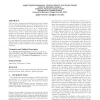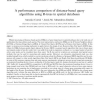12 search results - page 2 / 3 » Closest Pair Queries with Spatial Constraints |
GIS
2006
ACM
14 years 5 months ago
2006
ACM
The result of a distance join operation on two sets of objects R, S on a spatial network G is a set P of object pairs <p, q>, p R, q S such that the distance of an object ...
VLDB
1998
ACM
13 years 9 months ago
1998
ACM
: Structural queries constitute a special form of content-basedretrieval where the user specifiesa set of spatial constraints among query variables and asks for all configurations ...
ICDE
2009
IEEE
14 years 6 months ago
2009
IEEE
This work addresses a novel spatial keyword query called the m-closest keywords (mCK) query. Given a database of spatial objects, each tuple is associated with some descriptive inf...
ISCI
2007
13 years 4 months ago
2007
Efficient processing of distance-based queries (DBQs) is of great importance in spatial databases due to the wide area of applications that may address such queries. The most repr...
TKDE
2011
12 years 11 months ago
2011
—In reality, spatial objects (e.g., hotels) not only have spatial locations but also have quality attributes (e.g., price, star). An object p is said to dominate another one p , ...


